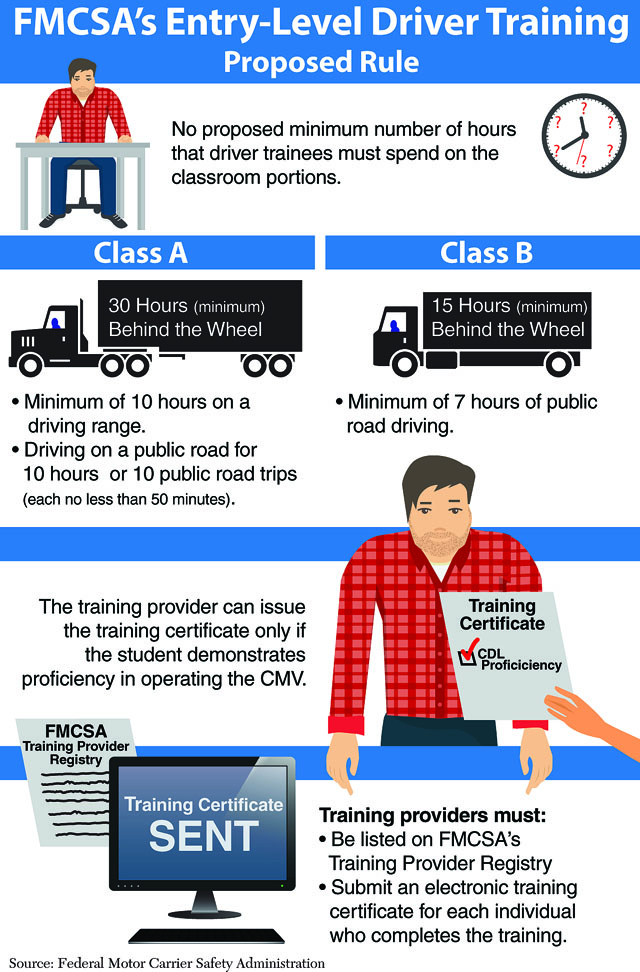Senior Reporter
Feds Propose Training Rule

This story appears in the March 14 print edition of Transport Topics.
The Federal Motor Carrier Safety Administration last week published its negotiated proposed entry-level driver training rule that would revise standards for a commercial driver license to be obtained by new interstate and intrastate commercial vehicle operators.
The proposal requires that Class A CDL driver-trainees receive a minimum of 30 hours of training behind the wheel, with at least 10 of those hours on a driving range. Of the remainder, 10 hours have to be on a public road or 10 public road trips — each being at least 50 minutes.
The proposal does not specify a minimum number of hours driver-trainees are to spend in the classroom.
Class B CDL driver-trainees must receive a minimum of 15 hours of training behind the wheel, with a minimum of seven hours on public roads.
A CDL classification is determined by the length, weight and complexity of the particular vehicle.
FMCSA said the rulemaking would enhance the safety of commercial motor vehicle operations on the nation’s highways by establishing “a more extensive entry-level driver training protocol and by increasing the number of drivers who receive the training.”
The proposal said that even if a student completes the minimum number of driving hours, a training provider must not issue the student a training certificate unless the student demonstrates proficiency in operating a heavy truck or bus.
Training would “reduce the frequency and severity of crashes” and promote “more efficient driving that has been shown to reduce maintenance and repair costs,” the proposal asserts.
The new training regimen would not take effect until three years after a final rule is published, the agency said. It will accept public comment through April 6.
Training facilitators have to meet minimum curriculum qualifications, be listed on FMCSA’s proposed training provider registry and submit electronically to FMCSA the training certificate for each individual who completes the training.
Don Lefeve, president of the Commercial Vehicle Training Association, said the proposed rule would help eliminate fly-by-night training firms that sometimes literally promise to train new drivers in a day.
“The training industry will be regulated for the first time under the proposed rule,” Lefeve told Transport Topics.
Safety is the chief concern of American Trucking Associations President Bill Graves as well.
“This rule does a good job of outlining the knowledge and skills a new driver should have before heading out on the road, but American Trucking Associations is concerned that an arbitrary requirement centered on behind-the-wheel training hours distracts from a more important focus on performance and safety outcomes,” Graves said.
“In general, we’re pleased with the rulemaking,” said Todd Spencer, executive vice president of the Owner-Operator Independent Drivers Association. “The negotiated rule process was positive, primarily because there were people involved that not only had a vested interest but also had awareness of the issues.”
FMCSA’s Entry-Level Driver Training Advisory Committee took four months to reach consensus in May 2015.
But despite voting in favor of the consensus, ATA and the National Association of Small Trucking Companies sent letters to the head of the committee complaining that there should be no hourly driving requirements because some students don’t need 30 hours to be qualified for a CDL, and others need more.
“The NPRM also proposes that a CDL holder who has been disqualified from operating a CMV must successfully complete refresher training,” the proposed rule said.
Military drivers, farmers and firefighters, generally excepted from the CDL requirements, would therefore be exempt from the proposed training rule.
Attempts by regulators to impose a prescribed course of training for novice drivers date to 1985, when the Federal Highway Administration’s Office of Motor Carriers, the predecessor to FMCSA, published a “Model Curriculum for Training Tractor-Trailer Drivers.”
Several attempts since have been rejected either due to a lack of industry support or inadequate justification that a rule’s benefits would outweigh its costs.
The Entry-Level Driver Training Advisory Committee included 25 representatives from motor carrier transportation, highway safety, driver training, state licensing, law enforcement, labor union and insurance organizations.
Bryan Spoon of Grandy, North Carolina, an independent owner-operator and member of the committee, called the proposed rule “a good first step” and was complimentary of the negotiation process used to craft the proposal.
“I really thought it was going to be a knock-down, drag-out that probably was going to end in some recommendations but without consensus,” Spoon said. “But really, the people around that table were a lot more on the same page than you would have thought.”
Peter Kurdock, director of regulatory affairs for Advocates for Highway and Auto Safety, said his organization was “generally happy” with the proposal.
“It reflects the consensus we reached on the ELDT committee,” Kurdock said. “We think it will move the needle on safety.”

